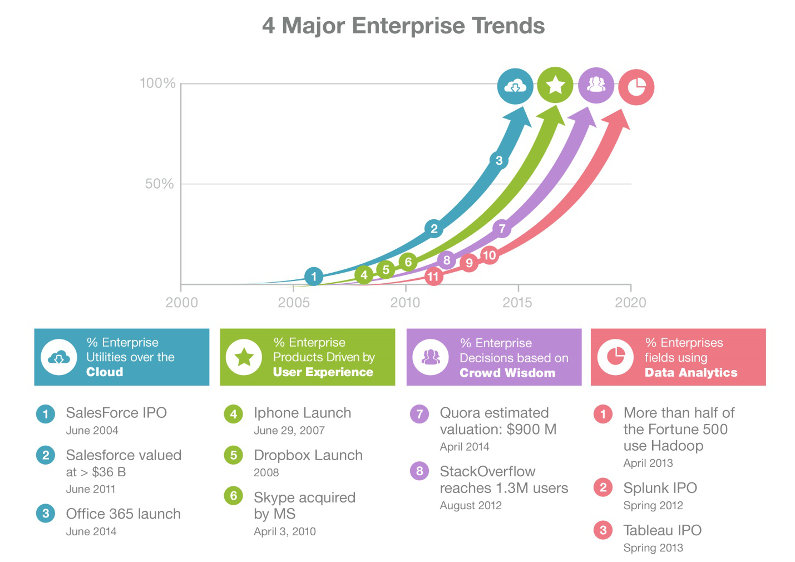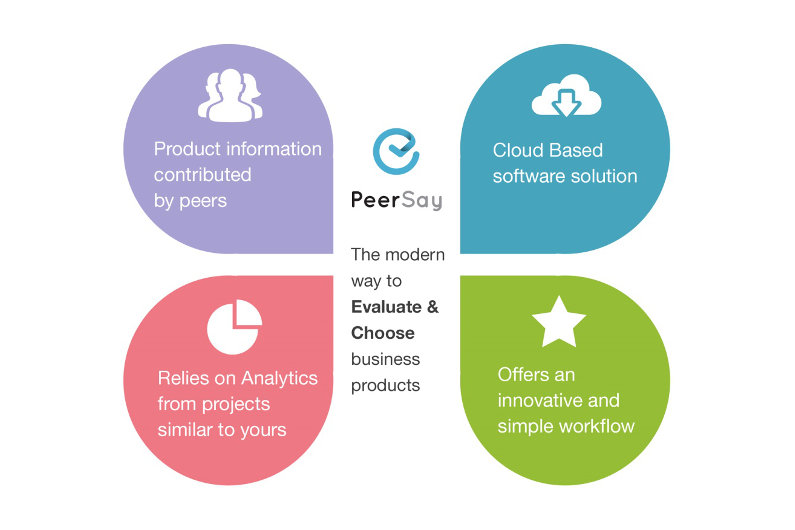According to Gartner the annual spend of enterprises on IT products exceeds three trillion dollars. Until recently, the way decision makers selected and purchased IT products has been based on a traditional process that was stagnant for decades. Enterprise software has always lagged behind platforms and apps that targeted the consumer. YouTube, Snapchat and Facebook were designed for the masses. In other words, if consumer software is the young, vibrant “prom queen”, enterprise software has been the “conservative business woman”.
Not anymore. Here are four trends in the enterprise arena that are happening right now, and together they are pushing the enterprise to catch up with consumer products.

Trend 1: The Cloud
In just a decade, who would have imagined that enterprises would trust the cloud with their most precious intellectual property, from CRM data to sales documents. Then came Salesforce, which, beyond all corporate wisdom, evolved the CRM market step-by-step, to the very point that the company is valued over $40 billion.
Today the cloud is more secure than before. A recent BT study showed that 70% of executives still don’t trust the cloud. Despite their concerns, 80% of execs are adopting cloud storage and web-based applications.
In fact, according to Bill McNee of Saugatuck Technology, by 2018, more than 60% of enterprises will have at least half of their infrastructure on cloud-based platforms. Even Microsoft, the giant of desktop software, launched Microsoft 365, an online version of their office suite.
Trend 2: User Experience Focus
From every responsive screen to color scheme, enterprise software is embracing the same philosophy that made the iPhone and iPad beloved and ubiquitous: UX. User experience – ease of use, simplicity and flow – is becoming key criteria for product selection. Enterprise leaders are used to the sleek design one finds in consumer products, and they expect the same in their business environment.
Businesses also want their employees to hit the ground running, and a slow learning curve that requires copiously-worded user manuals, slide decks and hours of video tutorials wastes time and money.
What’s another big driver of sleeker enterprise design? Portability. With Bring your own Device (BYOD) playing a major role in the workplace, your accountant, CEO and marketing director, regardless of location, are already accessing company data via new, UX driven applications.
Paypal, Dropbox and Skype are just a few examples of companies that introduced a leap forward in UX, allowing users to enjoy a new level of convenience by changing the very way people buy, share files or communicate with one another. Thanks to these advances in sleek UX, company executives will never return to the way enterprise software looked – or functioned – as before.
Trend 3: Crowd Wisdom
In both software and real life, a nod from the masses = legitimacy. So, companies are seeking the same help in reaching decisions at work as they do when they search for a hotel room on Expedia or a restaurant on Yelp! Quora and Stackoverflow are two examples of crowd wisdom platforms making a huge impact, with millions of users asking questions and finding the answers they need within seconds.
Employers are using crowdsourcing to find potential employees on LinkedIn, gain product feedback on Amazon Turk, and find freelancers on any number of sites. Counting on the crowd for wisdom in private buying decisions, more and more enterprise-level workers want to rely on the same input to make purchases in their business environment.
Trend 4: Big Data
In a groundbreaking study last year by Accenture and GE, Big Data took center stage. In the survey, almost 90% of professionals thought that companies that fail to adopt a Big Data strategy will definitely lose ground to competitors.
Hadoop, Splunk and Tableau are all Big Data technologies that are growing exponentially. Hadoop alone has penetration in 50% of Fortune 500 companies, an almost unheard-of success rate in the software and technology world.
The New Way to Select Enterprise Products
The decision-making process of buying enterprise software can be quite arduous. Executives traditionally conduct research, consult with experts or trusted colleagues, compare alternatives and then make a decision, which is more based on what data is available at the moment over what data is the most comprehensive and helpful.
This traditional method is going to die soon. With the four major trends of The Cloud, Crowd Wisdom, Big Data and User-Experience, it’s only natural that enterprise executives will seek a more comprehensive, easier, more robust, quicker way to select products. Such platforms are emerging. G2Crowd and Trustradius provide user reviews on enterprise products. SoftwareAdvice that was acquired by Gartner is another such example.

PeerSay takes the user selection process to the cloud, brings in the wisdom of the crowd, adds Big Data analytics and offers an incredibly simple user design. With PeerSay, modern enterprise purchasing is finally here.



